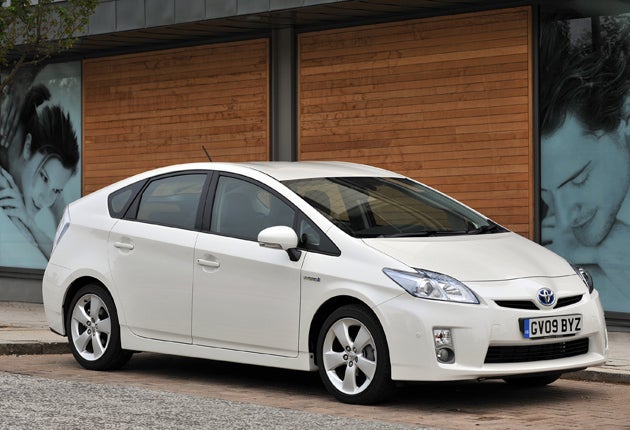Toyota Prius
This new Prius does more of what it says on the tin

Your support helps us to tell the story
From reproductive rights to climate change to Big Tech, The Independent is on the ground when the story is developing. Whether it's investigating the financials of Elon Musk's pro-Trump PAC or producing our latest documentary, 'The A Word', which shines a light on the American women fighting for reproductive rights, we know how important it is to parse out the facts from the messaging.
At such a critical moment in US history, we need reporters on the ground. Your donation allows us to keep sending journalists to speak to both sides of the story.
The Independent is trusted by Americans across the entire political spectrum. And unlike many other quality news outlets, we choose not to lock Americans out of our reporting and analysis with paywalls. We believe quality journalism should be available to everyone, paid for by those who can afford it.
Your support makes all the difference.Here it is, the best-known hybrid of all now with a new (but recognisable) look, a new engine and new claims. First, the vital numbers.
The official CO2 rating is down from 104g/km to a remarkable, no-road-tax 89, by far the lowest figure of any car of this size. Yet power rises from 113 to 136bhp, giving enough punch to make the Prius feel as frisky as its rivals instead of making you suffer for your greenness. And prices are unchanged, from £18,370.
This all sounds too good to be true if you're the sort of car buyer who likes the idea of something innovatively green but who doesn't want to be seen as a tree-hugger. But then I've always liked the idea of the Prius. It does seem illogical to carry two types of engine in one car, but the physics do work, especially in a low-speed urban environment when driving on the electric motor alone. Thereafter the motor helps out the petrol engine when needed and acts as a generator to charge the battery pack when not.
Fine. A Prius was ever thus. But the idea fell apart slightly when you asked it to zoom along a motorway, on which its 1.5-litre engine struggled and economy suffered. Suddenly those amazing CO2 figures melted away and the Prius was less economical than a simple diesel.
Now, with European driving conditions in mind, the new Prius has a bigger, more muscular, 1.8-litre engine able to run in a more efficient, relaxed way on the motorway. This, plus cleverer control units, a more efficient electric motor and a neat system to recover exhaust heat for a quick engine warm-up, not only improve the official CO2 result but make the Prius more economical in the real world. Now it really does make sense.
You feel the difference within a few hundred yards. Before, you would hear the engine spinning frantically as it tried to produce what was asked of it, now it stays in the background, its aural output hard to distinguish from the general sound of motion.
Switch the central display panel to the usual Prius schematic diagram, and you can see how the energy flows between engine, motor, battery and wheels. This panel is now in two layers, so the displays seem suspended in space; another information option, replicated on the optional (and slightly distorted) head-up display on the windscreen in front of the driver, shows if, and by how much, the battery is being charged, which alters dramatically as you move the accelerator.
Also new are the three drive modes which, like the charging display, resemble those found in Honda's recently launched Insight. Eco calms down the power delivery, Power peps it up, but the difference between these and the leave-it-to-its-own-devices setting is subjectively minimal. And then there's EV, or Electric Vehicle, which keeps the engine inoperative and disconnected provided there's enough battery and you don't go over 31mph. As before, there's a "B" position on the transmission selector lever which increases regenerative braking, felt as a greater tendency to slow when you ease off the accelerator.
Another big difference between this Prius and the old one is the potential for pleasure. The suspension and understructure are shared with the new Toyota Verso MPV and, as configured for the Prius, they underpin a car with smooth, accurate steering, a supple ride and a fluent demeanour.
The optional 17-inch wheels sharpen the responses, but if you have these you can't have the solar-cell glass roof. The Prius engineering chief told me the reason is that the roof is heavy and someone wanting the "fun-to-drive" of the big wheels wouldn't want that fun compromised by the higher centre of gravity. This is an unrealistically purist view given that most people buy bigger wheels for the looks alone; the reality is that the heavier wheels plus heavier roof would tip the Prius into a higher weight category which would force it to be recertified at considerable expense.
Today's Prius is still futuristic but no longer strange and its green credentials are now credible. You can't help admiring it. You would probably enjoy owning it, too.
The Rivals
Ford Mondeo 2.0 TDCi ECOnetic 5dr (139g/km and 115bhp):
£20,145.
Turbodiesel family car but figures for fuel consumption and power are no longer all that impressive.
Honda Insight (101g/km and 87bhp):
from £15,490.
Smaller, simpler hybrid than a Prius, feels cheaper and is. Engine never fully disconnects from electric motor.
VW Passat 2.0 TDI Bluemotion 2 (128g/km and 110bhp):
£18,095.
VW's Bluemotion cars are more eco-modified than Ford's ECOnetics. Good effort, but shaded by Prius.
Join our commenting forum
Join thought-provoking conversations, follow other Independent readers and see their replies
Comments